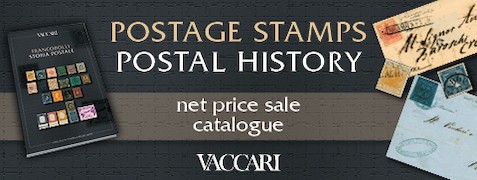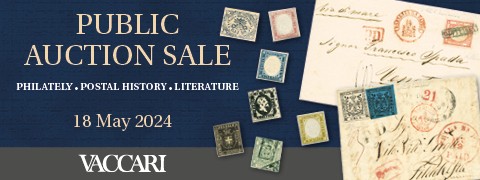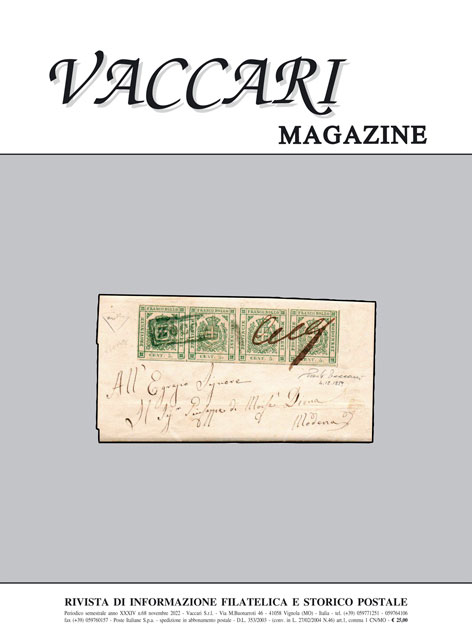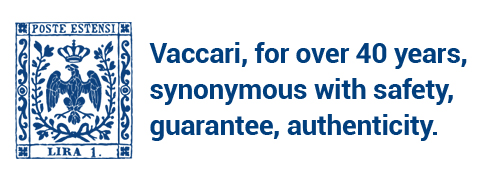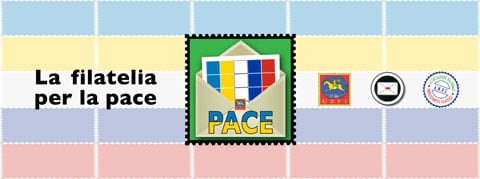Philatelic Bookshop
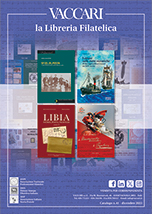
General catalogue
with recent updates
Philately and postal history, postcards, catalogues, colonies, forgeries, fiscals, handbooks, air mail, maritime and military, preadhesive, postal rates, thematics, numismatics and general collecting.
Cod. VM68
EUR 25,00
PACKAGE DEALS ON BACK ISSUES
- 6 TO 10 ISSUES 20% OFF
- MORE THAN 10 ISSUES 30% OFF
VACCARI MAGAZINE
anno 2022 - n.68
anno 2022 - n.68
144 pp. - colour ill. - format cm 20x27 - high quality glossy paper - softbound
special issue
ALSO AS FREE BOOK (class B)
A MAGAZINE TO COLLECT
"Vaccari magazine", the six-monthly specialised in philately and postal history, was born in 1989. Since then, it has been publishing articles and columns about traditional philately, but also some "topical" themes, thanks to the cooperation of lovers, scholars and journalists, experts of the subject.
It is characterized by the high quality of the deep studies proposed and by a very good graphical layout thanks to which it is one of the best awarded magazines in the world.
Last issue, no.68, a special one with 144 pages, was published in November 2022.
- research and innovation at the service of collectors, scholars and lovers
- deep studies presented in a simple and clear way
- several exemplifying images
- precious graphical layout
- important international awards
- incredible results of back issues at the auctions
- free full index
CONTENTS
Vaccari Magazine n.68 - 2022
Editoriale
Vaccari Valeria, Dedicato a papà
Vaccari Paolo, Primi giorni
Vaccari Paolo, Francobolli dell'800 e del '900
Bonacina Fabio, Ci sono cassette e cassette
Pigini, Rosalba, Il ritorno di FilateliCa
Carra Lorenzo, I rapporti postali del Regno Lombardo Veneto con il Regno di Sardegna, poi d'Italia 1815-1866
Bernstein Benjamin, Ferroni Massimiliano, Serone Mario, Rassegna dei colori più interessanti della prima emissione del Lombardo Veneto
Luraschi Francesco, Savini Luca, L'annullo circolare di Milano con data e ore. Quando un timbro diventa un affare di Stato
De Biasi Marco, Annulli bellunesi a doppio cerchio con i baffi
Stumvoll Heinrich, Il più piccolo di Venezia. L'uso del bollo stampatello diritto nero e rosso
Buffagni Giuseppe, Studio degli annullamenti degli uffici degli Stati Estensi
Dallara Enrico, Le regole sanitarie della posta di Parma. La disinfezione delle lettere provenienti dal Genovesato e dall'Alta Lunigiana
Moritsch Massimo, Quondamatteo Roberto, Lettere con affrancatura insufficiente dallo Stato Pontificio al Regno d'Italia. 1° ottobre 1867 - 31 ottobre 1870
Alessio Stefano, Cose di Sardegna
Bottacchi Giacomo, Arona: separati da 169 anni si riuniscono (se son rose... fioriranno!)
Simonazzi Emilio, Riscoperte
Moritsch Massimo, Trattamento delle lettere toscane per Alessandria d'Egitto dal 1836 al periodo filatelico
Mentaschi Mario, Nembrini Giovanni, Le tariffe degli stampati nel periodo dell'Unione Generale delle Poste (GPU). 1° luglio 1875 - 31 marzo 1879
Forti Gianluigi Maria, Regno di Carlo Alberto e Vittorio Emanuele II. L'evoluzione dei trasporti marittimi e terrestri
Fumu Antonello, Transito per il porto di Alessandria d'Egitto della posta per e dalle Indie Orientali negli anni 1850-1871
Lunati Piergiorgio, Il lineare "Traforo Moncenisio" in uso durante la costruzione di un'opera ciclopica: il tunnel del Frejus
Giovanardi Carlo, Fiume: da un piccolo sostantivo una grande storia
Occhipinti Marco, La corrispondenza dei confinati politici
De Signoribus Giorgio, Uso tardivo dei soprastampati "P.M." (Posta Militare) della prima emissione dell'11 settembre 1942 per corrispondenza civile in Italia
Riccitelli Flavio, Il servizio postale regolare della L.A.T.I. sulla rotta sud-atlantica
EDITORIAL
Vaccari Magazine n.68 - 2022
I never wanted to write and sign this editorial in my dad's place.
A long story, that of the Magazine, which could have continued but, by his will, ends here.
I thank personally and also on behalf of my dad (I know he would have done so) all of our writers, many of whom have collaborated with the magazine since the first issue in 1989; all the subscribers and readers who have been following and supporting us.
I thank those who believed in this forward-looking project and published their own advertisements.
I thank all the editorial staff, Francesca who started and Claudia who continued, the makers-up Katia and then Federica. And the typography that accompanied us from the beginning.
A great adventure dad, which I will miss a lot, especially because that was with you.
In this issue some pages are dedicated to him.
Many of the authors had already sent the material for next issue, because the full article would have been divided into several parts. I therefore thought it was right to create a special issue, last one, with more pages than those which characterize the other 67 magazines, to be able to accommodate everything received so far.
Unfortunately, some of the studies divided into many parts will not find a conclusion.
Giuseppe Buffagni, in this second part on the cancellations of the Este States, presents the offices of Camporgiano, Carpi, Carpineti and Castelnuovo di Garfagnana; Flavio Riccitelli reaches the nineteenth part with the regular postal service of the L.A.T.I. on the South Atlantic route developing Paraguay.
Lorenzo Carra, instead, comes to a point with the year 1866 and the end of the Lombardy Venetia Kingdom, in his analysis of relations with the Kingdom of Sardinia from 1815. Last part also for Giorgio De Signoribus, on the late use of the overprinted "P.M." of the first issue (11.9.1942) for civil correspondence in Italy, and for Marco Occhipinti who, with the correspondence of political internees, takes us to Belvedere Marittimo and Cerchiara di Calabria.
Among the new authors there are two long-standing collaborators who, however, are now signing their own contribution: Giacomo Bottacchi joins again, albeit ideally, an original strip of four of Sardinia cent.5 (issue 1.10.1853) after more than a century and a half; Mario Serone, together with Benjamin Bernstein and Massimiliano Ferroni, proposes a review of the most interesting colours of the first issue of Lombardy Venetia.
New are also Enrico Dallara, who analyses the signs of disinfection on letters from Genoa area and Alta Lunigiana according to the health rules of Parma post; Piergiorgio Lunati, who follows the construction of the Frejus tunnel and the contemporary use of the line mark "Tunnel Moncenisio"; Francesco Luraschi, who, with Luca Savini, tells us about when a postmark, the Milan circle with date and hour, becomes a state affair.
Rosalba Pigini offers us a brief report on "FilateliCa 2022". Fabio Bonacina retraces the evolution of mailboxes showing some curiosities. Carlo Giovanardi investigates between Fiume and Lucca starting from a small noun.
Emilio Simonazzi rediscovers a letter from the Kingdom of the Two Sicilies to the Duchy of Modena of which not only traces had been lost but few had been aware of it. Stefano Alessio proposes a funny, colourful and engaging, partly unusual, collection of Sardinia.
Marco De Biasi illustrates Belluno double circle cancellations with moustache; Heinrich Stumvoll the smallest postmark in Venice, the Roman capitals one in black and red.
Antonello Fumu passes through the port of Alexandria in Egypt departing for and arriving from the East Indies (1850-1871). Massimo Moritsch examines the treatment of Tuscan letters addressed to Alexandria in Egypt (1836-philatelic period), and, with Roberto Quondamatteo, letters with insufficient franking from the Papal State to the Kingdom of Italy (1.10.1867-31.10.1870).
Mario Mentaschi and Giovanni Nembrini study the rates for printed matter during the period of the Post General Union (1.7.1875-31.3.1879), and Gianluigi Maria Forti sea and land transports during the reigns of Carlo Alberto and Vittorio Emanuele II.
Signed by Paolo Vaccari, the opening column dedicated to the somewhat particular "items" of the Nineteenth and early Twentieth centuries, and two "first day" letters relevant to the Kingdom of Naples and the Naples Provinces.
Valeria Vaccari
November 2022
latest news
- Quei capitoli molto… storici
Occupazioni, uffici all’estero, colonie e posta militare... - In asta, il 18 maggio
Sono 1.438 i lotti che transiteranno dalla sede della... - Editoria: la promozione fino al 17 aprile
Firmata dalla società Vaccari, l’iniziativa prevede... - Niente spese, ma fino al 28 marzo
Ancora pochi giorni per approfittare della promozione...
Copyright © 2024 - 1996 Vaccari srl
All rights reserved
All rights reserved



